Hong Kong Port(Chinese:香港港) is located in the Pearl River Delta in the South China Sea, and is a deep-water seaport. It is close to Shenzhen Port and Guangzhou Port.On the east side outside the Pearl River Estuary, between Hong Kong Island and the Kowloon Peninsula.
Hong Kong Port is one of the busiest and most efficient international container ports in the world and a major hub port in the global supply chain. There are currently more than 80 international liners providing about 500 container liner services per week, connecting Hong Kong Port to more than 500 destinations around the world.
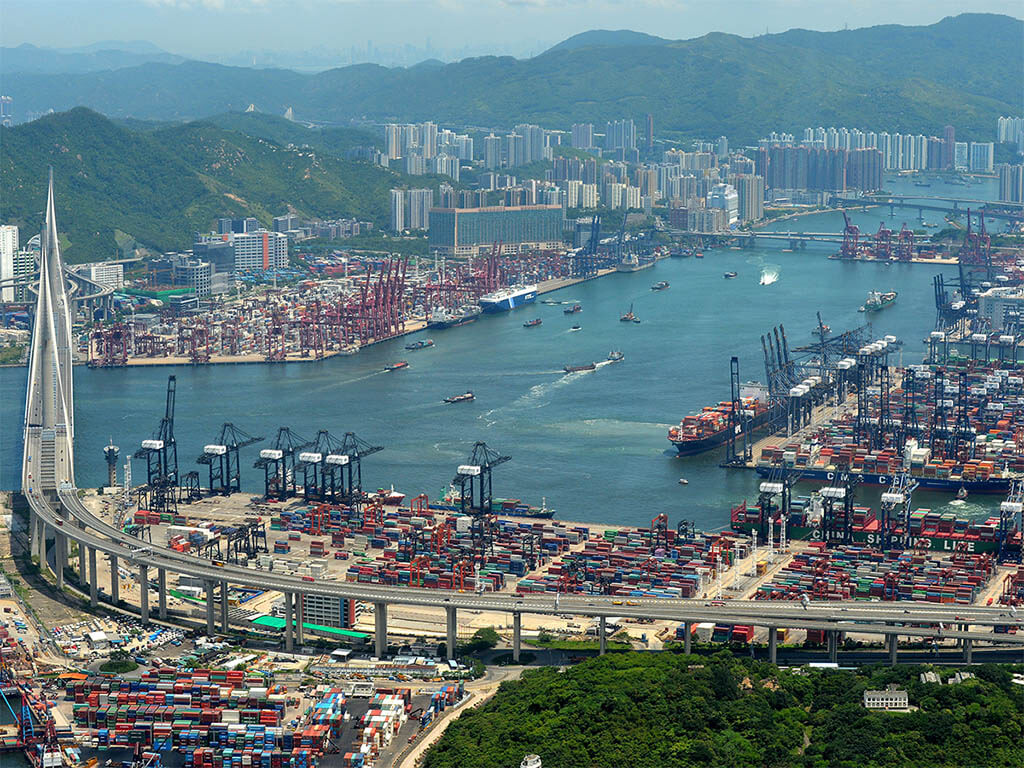
Port area composition
Hong Kong Port has 15 port areas: Aberdeen, Castle Peak (Tuen Mun), Cheung Chau, Kat O, Lau Fau Shan, Saigon, Sha Tau Kok, Sham Tseng, Silver Mine Bay, Stanley (East), Stanley (West), Tai Australia, Tai Po, Tap Mun and Victoria.
Among them, Victoria Port is the largest and has the best conditions. Its average in-harbour channel of more than 10 meters deep allows large ocean-going cargo ships to enter the dock and loading and unloading area at any time, providing a convenient and safe berth for ships around the world.
Matching with this, Hong Kong also has excellent port facilities and efficient operation procedures, and advanced port management. Hong Kong’s cargo handling operations are known for their high efficiency. The average turnaround time of container ships in the port is about 10 hours. it is 42 and 52 hours respectively.Its port accommodates hundreds of ships to berth and carry out loading and unloading operations.
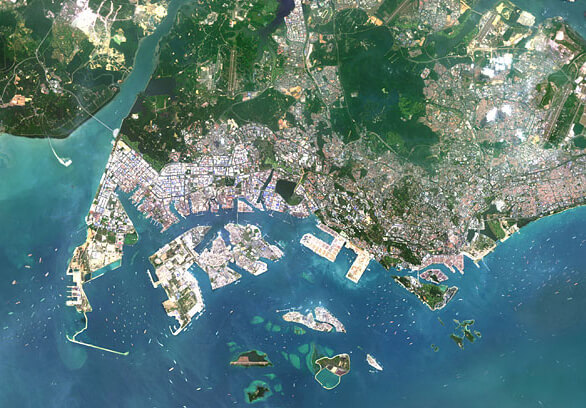
Port business
Hong Kong not only has container terminals, but also has special terminals for oil, coal and cement. Its port rate is among the lowest in the world. Hong Kong Port, which has ranked first in container throughput in the world for several consecutive years, was second in 2006 after being replaced by Singapore in 2005, with a throughput of 23.234 million TEUs, a year-on-year growth rate 2.8%.
Hong Kong Port is a free port. There are more than 20 maritime routes to nearly 1,000 ports in more than 120 countries and regions in the world. There are 10 million passengers entering and leaving Hong Kong every year. Hong Kong ranks among the world’s largest ports in terms of cabin tonnage, cargo handling capacity and passenger traffic of port facilities.
Affected by many factors such as weak global trade, insufficient terminal land, and the rise of inland terminals, the container throughput of Hong Kong terminals was overtaken by Ningbo Port in the first 11 months of 2015, resulting in a further decline in the global ranking to fifth place in 2015.
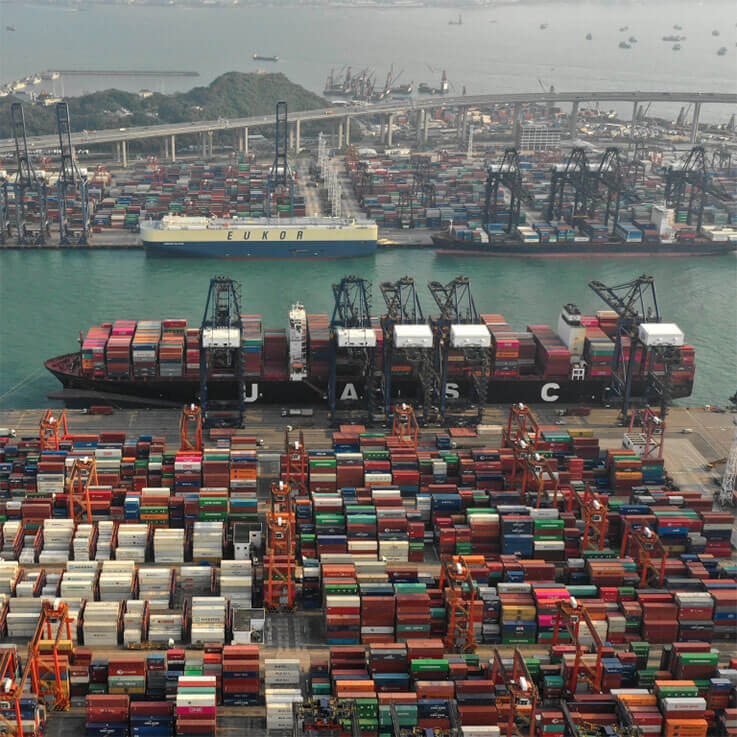
Ferry services
The Hong Kong-Macau Ferry Terminal between Central and Sheung Wan and the China Ferry Terminal in Tsim Sha Tsui provide centralised ferry services to Macau and 24 ports on mainland China.
About 100 vessels, mostly high-speed passenger craft such as jetfoils, catamarans and hoverferries, operate from these terminals. In 2001, over 17 million passengers passed through the terminals, comprising approximately 11.2 million passenger trips to/from Macau and 6.5 million passenger trips to/from mainland ports.
Container Port traffic
The port has been one of the busiest container ports in the world for many years, and at times the busiest.
It was the world’s busiest container port from 1987 to 1989, from 1992 to 1997, and from 1999 to 2004. The amount of container ships that went through Hong Kong’s container port was 25,869 in 2016, with a net register tonnage of 386,853 tonnes in 2016.
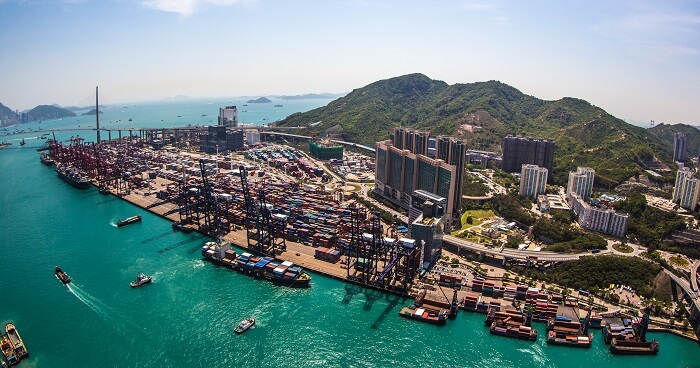
Functional buildings
Container terminals
There are currently nine container terminals situated at Kwai Chung, Stonecutters Island and Tsing Yi (the last one completed in 2004). Substantial container throughput is handled by the River Trade Terminal at Tuen Mun and by mid-stream.
Kwai Tsing Container Terminals
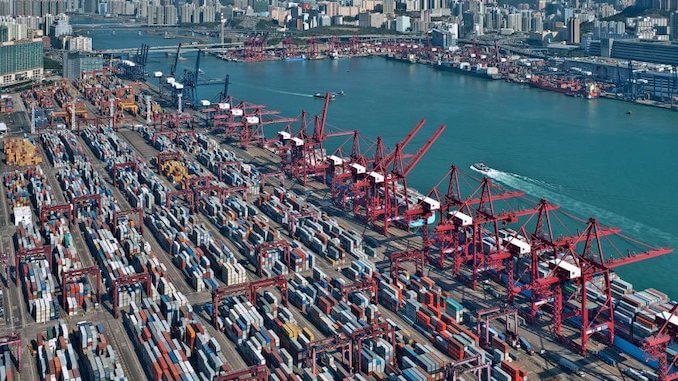
The Kwai Tsing Container Terminals (Kwai Chung Container Terminals until Container Terminal 9 was opened on Tsing Yi), located in the north-western part of the harbour, has nine container terminals with 24 berths of about 8,500 metres of frontage.
It covers a total terminal area of about 2.7 km² which includes container yards and container freight stations. The nine container terminals have a total handling capacity of over 18 million twenty-foot equivalent units (TEU).
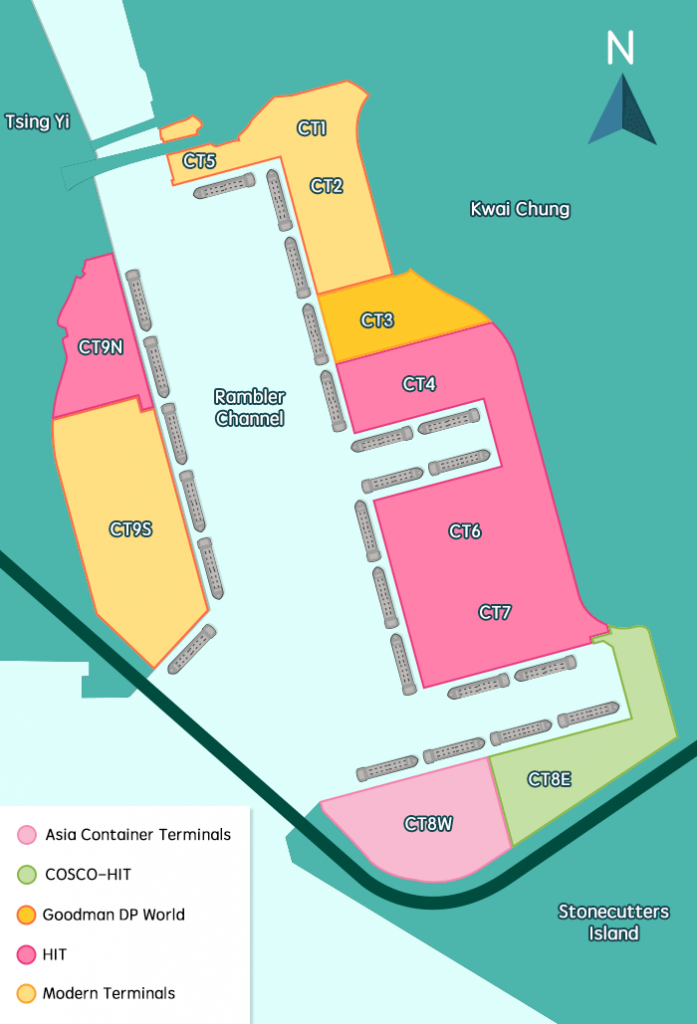
These terminals are operated by five companies, namely:
Modern Terminals Ltd. (MTL)
Hongkong International Terminals Ltd. (HIT)
COSCO Information & Technology (H.K.) Ltd. (COSCO)
Dubai Port International Terminals Ltd. (DPI)
Asia Container Terminals Ltd. (ACT)
The existing 9 terminals occupy 2.17 square kilometres of land, providing 18 berths and 6,592 metres deep water frontage. These terminals handle about 60% of total container traffic handled in Hong Kong.
River Trade Terminal at Tuen Mun
The River Trade Terminal at Tuen Mun involves the consolidation of containers, break bulk and bulk cargo shipped between the Hong Kong port and ports in the Pearl River Delta.
The terminal is located near Pillar Point in Tuen Mun, New Territories, and is operated by River Trade Terminal Company Ltd. The 65-hectare terminal, completed in November 1999, has about 3,000 metres of quay, according to Hong Kong Port Development Council data.
Mid-stream
Mid-stream operation involves loading and unloading containers to and from ships while at sea, with barges or dumb steel lighters performing the transfer, and then distributing or landing the containers to piers nearby.
Due to high handling fees at the container terminals, Hong Kong has become the only place in the world with at-sea loading and unloading operations.
Currently, there are 11 different yard sites solely for mid-stream operations, occupying a total land area of 27.5 hectares and waterfrontage of 3,197 metres.
Drydocks and slipways
The port has extensive facilities for repairing, maintaining, drydocking and slipping of all types of vessels. Two floating drydocks are located off the west coast of Tsing Yi Island and two northeast of Lantau Island. The largest is capable of docking vessels up to 150,000 tonnes deadweight (DWT).
There is also a large number of smaller shipyards, which carry out repairs to vessels and build specialised craft, including sophisticated patrol craft and pleasure vessels for overseas markets.
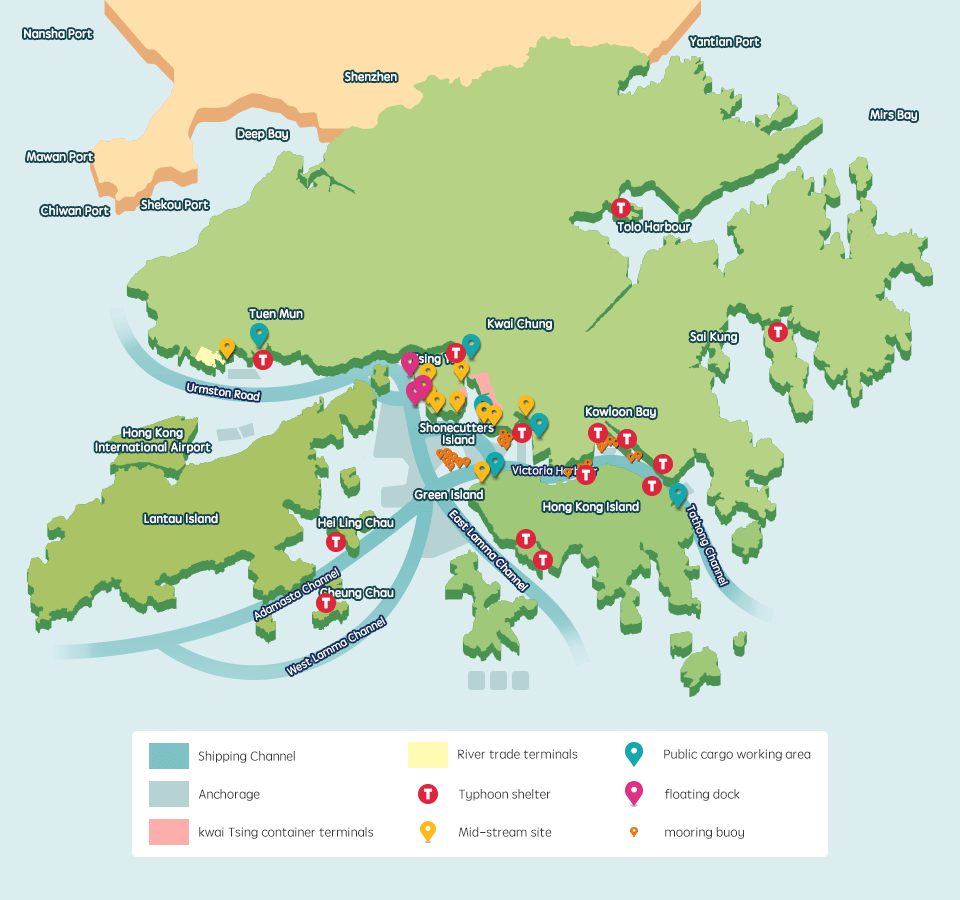
Moorings and anchorages
The Marine Department operates and maintains 58 mooring buoys for seagoing vessels. Of these 31 are suitable for ships up to 183 metres in length and 27 for ships up to 137 metres. There are 44 special typhoon mooring buoys to which ships can remain secured during typhoons.
This improves efficiency and reduces operational costs of vessels through elimination of unnecessary movements. In addition to the three Immigration and Quarantine Anchorages designated for visiting vessels to complete port formalities, there are eight dangerous goods and eight general-purpose anchorages providing temporary berthing spaces for vessels.
The areas and water depths of the anchorages are diversified to accommodate different sizes and draughts of ships calling at Hong Kong. There are over 460 modern marine aids to navigation throughout Hong Kong waters to guide mariners to and from their berths.
Other working facilities
To facilitate transfer of cargo between vessels and the shore, and cargo to and from Pearl River ports, the Marine Department provides and manages 7,756 metres of public cargo-working sea frontage in various parts of Hong Kong. Bulk handling facilities for coal and oil are provided at the power generating stations at Tap Shek Kok in Castle Peak and at Po Lo Tsui on Lamma Island.
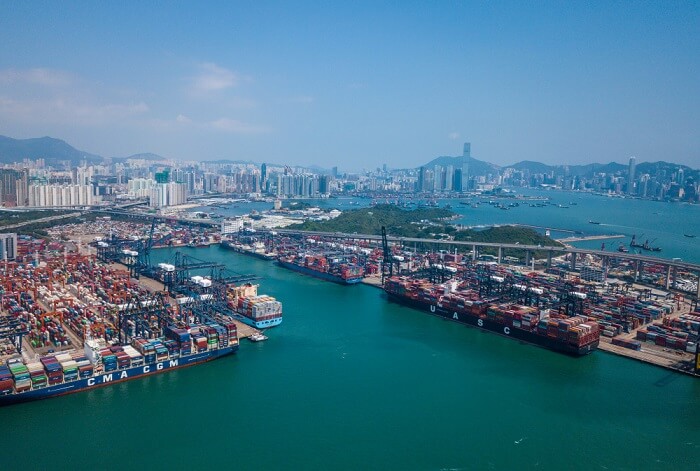
Hong Kong Port Data
- Country
- China
- Location
- Pearl River Delta, HongKong ,China
- Official name
- 香港港
- Status
- In use
- Operator(s)
- Hong Kong Maritime and Port Board (HKMPB)
- Port type
- Deepwater seaport
- Features
- Natural port, Artificial port, Free port
- Region
- East Asia
- Sea area
- South China Sea
- Annual cargo tonnage
- 281 million tons (2017)
- Annual container volume
- 19.6 million TEU (2018)
View Hong Kong Port on Google Satellite Map
Google satellite maps allow you to see building details more clearly, including natural landscapes such as mountains, rivers, deserts, sea and man-made engineering buildings.
If you are very interested in this engineering building, it is a good idea to click below Google Map icon. We will help you jump to the corresponding location of this building or engineering on Google satellite map.





























































